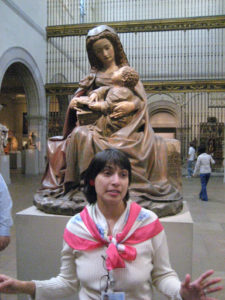(Photo: Chris Harris)
BURGUNDIAN MADONNA (VIRGIN AND CHILD)
Researched by Rochelle Almeida
33.23
Attributed to Claus de Werve (1380-1439), Franco-Netherlandish
French
Limestone, Polychromy gilding
1396-1439
Who was the sculptor of this piece?
This piece is attributed to Claus de Werve, an influential court sculptor in Dijon, France, active from 1396-1439. He created many works for his patrons and this is certainly one of his masterpieces.
Where was this sculpture created and why?
By the fourteenth century, the devotion to Mary was growing all over Western Europe and it became common to create representations of her in tapestry, wood and stone. This particular sculpture was commissioned by John the Fearless, Duke of Burgundy (died 1419) or his wife, Margaret of Bavaria (died 1424). Upon completion, it was presented by one of them to the Cloistered Convent at Poligny, in Burgundy, France, dedicated to the Franciscan Order of the Poor Clares. This is one of four large sculptures from Poligny in the Museum’s collection. Hence, this is often referred to as the Burgundy Madonna.
What were the materials involved in the creation of this piece?
This sculpture is made of limestone, a material frequently used for sculpting statues in the Medieval Age. It was then painted in bright and vivid colors, most of which have faded away with time and exposure to the elements, though some parts of this piece show evidence of greater preservation of the paint than others.
What does this sculpture depict?
This is a monumental yet deeply engaging and very intimate portrayal of the Virgin and the child or what has come, in Art, to be generically titled The Madonna.
What makes this sculpture so engaging?
The softness and naturalism with which the sculptor has endowed these individuals is what makes it so engaging. There is a serene maternal caring in the face of Mary as she seems to be entertaining her little one by reading to him verses from the Bible. Like most infants, Jesus is restless and squirms in her arms, while his foot seems to be kicking the book shut. It is this human touch that softens the portrait and makes it deeply appealing. The babe looks up pleadingly at its mother as if begging her to stop.
Visual Features:
The sculptor has included a number of humanistic details. Notice the beauty of Mary’s features—the broad forehead, the stylized hair falling in soft tresses around her face.
Her robes are full and fall in soft curves around her feet. The feel of the heavy fabric is suggested by the generosity of the folds and the manner in which they seem to swirl around the base. This denotes wonderful use of the medium—limestone—to create this feeling of soft abundant folds. Michaelangelo worked wonders with marble but note this use of limestone to create the same effect.
There is the Cloth of Honor on Mary’s head which in the Medieval Period, denoted Honor or Royalty. Since Mary was the mother of God, she is depicted as an honorable woman.
The babe is presented as a pudgy and cuddly person just like any other little baby. The fingers of Mary’s left land seem to dig into the pudgy side of the babe.
Where might this sculpture have been placed?
A close examination of the sculpture reveals greater evidence of paint preservation on the sides and the back. This has led art historians to believe that it might have been placed in a sheltered niche in the convent, probably on one of the stairway landings that the nuns would have to pass on their way to chapel each day. This explains why that part of the sculpture that might have been protected from the elements by the walls of the niche has fared better than the front which was far more exposed.
What does this sculpture signify?
Mary’s role as a personification of Wisdom is evoked by the open book on Christ’s lap. In contrast to the depiction of Mother and Son, the biblical inscription in Latin on the bench reminds us of Christ’s fulfillment of Old Testament prophecy: “From the beginning, and before the world, was I created…” (Ecclesiasticus 24:14).
Bibliography:
Holmes, Forsyth Williams: “A Fifteenth Century Virgin and Child”. Metropolitan Museum Journal, Vol. 21, 1986.
———:”A Medieval Virgin and Child”. MMA Bulletin, Vol. 3, No. 3, November 1944.
Norris, Mike: “Medieval Galleries”. From Class Notes taken during lecture delivered to Highlights Trainees in the Galleries on December 4, 2000.
www.metmuseum.org. (Metropolitan Museum of Art Web site).
